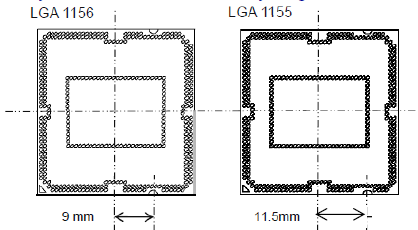
Posted on 04/21/2010 9:56:21 AM PDT by Ernest_at_the_Beach
We've got details in front of us of Intel's next generation platforms due in 2011, along with its 'Sandy Bridge' CPUs. A third party gave us this information - Intel won't comment on unreleased products.
Sandy Bridge CPUs will be based on the current 32nm, second generation High-k metal gate manufacturing process, but will include new architectural features such as AVX - Advanced Vector Extensions - and AES - Advanced Encryption Standard - acceleration and will arrive in Q1 next year, with possibly very limited products popping up late Q4, although depending on who we talk to the story changes.
They will be split into two markets: mainstream and enthusiast. The mainstream models will replace the current LGA1156 'H1' Clarkdale and Lynnfield CPUs (Core i3 and Core i5) and will use LGA1155 'H2' packaging.
Yes, that's right, LGA1155 - one fewer pins than current LGA1156 CPUs. These sockets are NOT compatible, so you cannot use an existing LGA1156 CPU in a new motherboard or visa versa. Not only is the position of pin-1 different, the socket notch has moved from 9mm to 11.5mm from the centre and the entire voltage plane layout has changed.
Mainstream Sandy Bridge CPUs will be both native dual- and quad-core products, currently targeting TDPs of 65W and 95W respectively, both with Hyper-Threading and Turbo Boost technology. At the moment it's not clear what frequency these CPUs will be though (likely because none are available yet from Intel).
All LGA1155 CPUs will have integrated graphics built into the core instead of a separate chip. This is an upgrade from the current IGP, PCI Express controller and memory controller in Clarkdale CPUs that is manufactured on the older 45nm process in a separate die (but still slapped together the same package). This should improve performance, as all the controllers will be in one die, like existing LGA1366 CPUs.

The LGA1155 CPUs will have an integrated dual-channel DDR3 memory controller, using the same 1,333MHz memory currently available: no change there then.
Socket change again....
LGA-144
I believe that the next great advancement in PC chip design will be the use of optical connectors instead of electrical pins.
What does this mean in layman’s terms? . . . espcially if one happens to own Intel stock?
for those building their own computer.,...it means to use the new processors (not yet available) they will need to buy a new motherboard as well as the processor...
Guess they get to use their current DDR3 memory and power supply....
Interesting. Thanks for the ping.
“LGA2011 socket (with) four channel DDR3 memory controller...
PCI Express 3 - of which we’ll get 32 lanes bolted into the CPU itself.”
Toss in a four, six or maybe even eight core CPU (with hyper-threading) and you have some serious speed and power there.
AM2+/AM3 is a far better platform!
“I believe that the next great advancement in PC chip design will be the use of optical connectors instead of electrical pins.”
The first few generations will still need eletrical power to drive the optical diodes inside of it.
But it will be cool, as light travels faster than electrons and you can have multiple frequencies of light over the same optical pin....
Not sure where Intel is going with performance....
Do you see much improvement over their current High End processors with this.?
By Sebastian Pop, Technology Editor
April 8th, 2010, 10:11 GMT
Intel's Sandy Bridge CPU Needs New Chipset
*******************************EXCERPT********************************
Intel Shares Vision for the Future
INTEL DEVELOPER FORUM, Beijing, April 13, 2010 – At its developer conference today, Intel Corporation demonstrated how the company is providing a foundation on which to build common hardware, software and ecosystem solutions to make computing experiences and devices work together seamlessly and easier to use. The Intel Developer Forum kicked off with a keynote by David (Dadi) Perlmutter, executive vice president and co-general manager, Intel Architecture Group (IAG), who shared Intel's vision to make it possible for technology users to realize the potential for a common connected computing experience.
"With an additional 1 billion connected computing users by 2015 and with more types of devices there is value in providing a common experience between the devices," said Perlmutter. "Intel architecture delivers the right combination of performance and power that provides the foundation across all computing devices creating a virtual continuum of computing to enable this common user experience."
My speculation is that this is all about getting better integrate performance from the graphics so HP will stop putting Nvidia graphics chips in the HP Laptops....
That’s an interesting thought and cpu’s have definitely been trending that way.
Intel’s onboard video has always been less than impressive.
well, hot stuff!
Disclaimer: Opinions posted on Free Republic are those of the individual posters and do not necessarily represent the opinion of Free Republic or its management. All materials posted herein are protected by copyright law and the exemption for fair use of copyrighted works.